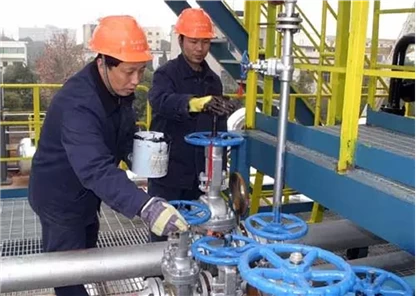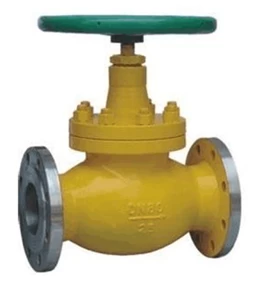Characteristics and precautions of common valves in petrochemical industry
The role of petrochemical valves
1. Open and close function-cut off or communicate the flow of fluid in the pipe;
2. Regulation function-adjust the flow and velocity of the pipe;
3. Throttle effect-make the fluid produce a great pressure drop after passing through the valve;
4. Other functions-a. Automatic opening and closing b. Maintaining a certain pressure c. Steam blocking and drainage.

Petrochemical valve classification
1. According to purpose : cut-off valve, high pressure control valve , diverter valve, check valve, safety valve;
2. According to the force : other action uses valve, automatic action valve.
Main parameters of petrochemical valves
PN ➨Nominal pressure (the maximum pressure that allows fluid to pass through)
DN ➨Nominal diameter
TN ➨temperature range (allowable fluid temperature range)

Check before use of petrochemical valves
Inspection items include:
1. Whether there are defects such as blisters and cracks on the inner and outer surfaces of the valve;
2. Whether the valve seat and the valve body are firmly joined, whether the valve core and the valve seat are consistent, and whether the sealing surface is defective;
3. Whether the connection between the valve stem and the valve core is flexible and reliable, whether the valve stem is bent, whether the thread is damaged or corroded;
4. Whether the packing and gasket are aging and damaged;
5. Whether the valve opening is flexible, etc.
Petrochemical valve use problems
1. Leakage of flanges and threads at the connection with the pipeline;
2. Packing culvert leakage, waist pad leakage and valve stem cannot be opened;
3. The valve core and the valve seat are not tightly closed to form internal leakage.
The following briefly introduces several commonly used valves
1. Gate
valve Gate valve,
also called gate valve, is a widely used valve. Its closing principle is
that the sealing surface of the gate and the valve seat are highly smooth, flat
and consistent, and they are closely attached to each other to prevent the
medium from flowing through, and rely on the top mold, spring or the mold shape
of the gate to enhance the sealing effect. It mainly cuts off in the
pipeline.
Its
advantages are: low fluid resistance, easy opening and closing, can be used in
the case of two-way flow of the medium, no directionality, the sealing surface
is not easy to be eroded when fully opened, the structure length is short, not
only suitable for small valves, but also suitable for making Big valve.
Gate
valves are divided into two types according to the thread of the valve stem,
one is the exposed stem type, and the other is the concealed stem
type. According to the structure of the gate, there are two types, one is
parallel, and the other is mode.

2.
Globe valve
The globe valve, also called the cut-off
valve, is the most widely used valve. The reason why it is so popular is that
the friction between the sealing surfaces during the opening and closing
process is small, it is more durable, and the opening height is not large. It
is easy to manufacture and convenient to maintain. It is not only suitable for
medium and low pressure, but also for high pressure.
Its
closing principle is to rely on the pressure of the valve stem to make the disc
sealing surface and the valve seat sealing surface closely fit to prevent the
medium from flowing.
The
shut-off valve only allows the medium to flow in one direction and is
directional when installed. Its structural length is greater than that of
the gate valve, and the fluid resistance is large, and the sealing reliability
is not strong during long-term operation.
There
are three types of globe valves: straight-through, right-angle and direct-flow
oblique globe valves.

3.
Butterfly
valve
The butterfly valve is also called the butterfly valve, as the name
implies, its key components are like a butterfly facing the wind, which can
swing freely.
The
disc of a butterfly valve is a disc, which rotates around an axis in the valve
seat. The size of the rotation angle is the opening and closing degree of the
valve.
Butterfly
valve has the characteristics of light weight, saves material than other
valves, simple structure, quick opening and closing, both cut-off and
throttling can be used, fluid resistance is small, and operation is
labor-saving. Butterfly valves can be made into large
diameters. Where a butterfly valve can be used, it is best not to use a gate
valve, because a butterfly valve is more economical than a gate valve and has
better adjustability. Currently, butterfly valves are widely used in hot
water pipelines.
4. Ball
valve
The working principle of ball valve is to make the valve unblocked or
blocked by rotating the valve. Valve switch light , small size , can be made large
caliber , reliable sealing , simple structure , easy maintenance , spherical surface and
seal often in the closed state , can't easily
be medium erosion , it has been
widely used in various industries. There are two types of ball
valves , one is floating ball
type , and the other is fixed ball
type.
In addition to the above valves, high pressure control valve are also used in the petrochemical field. The design and manufacture of control valves have strict requirements.
 +86 512 68781993
+86 512 68781993 


















